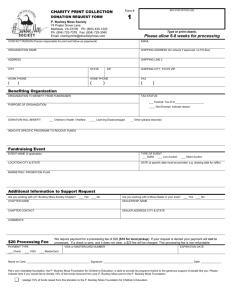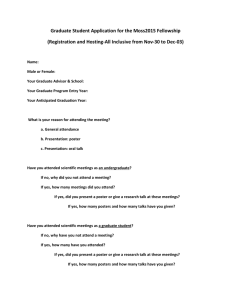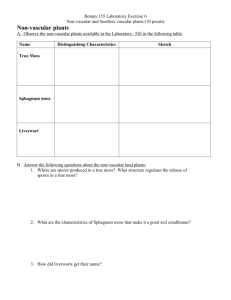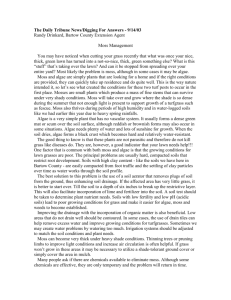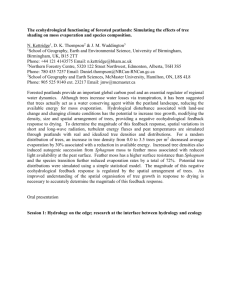peeling, flaking exterior paint & moss or algae on
advertisement
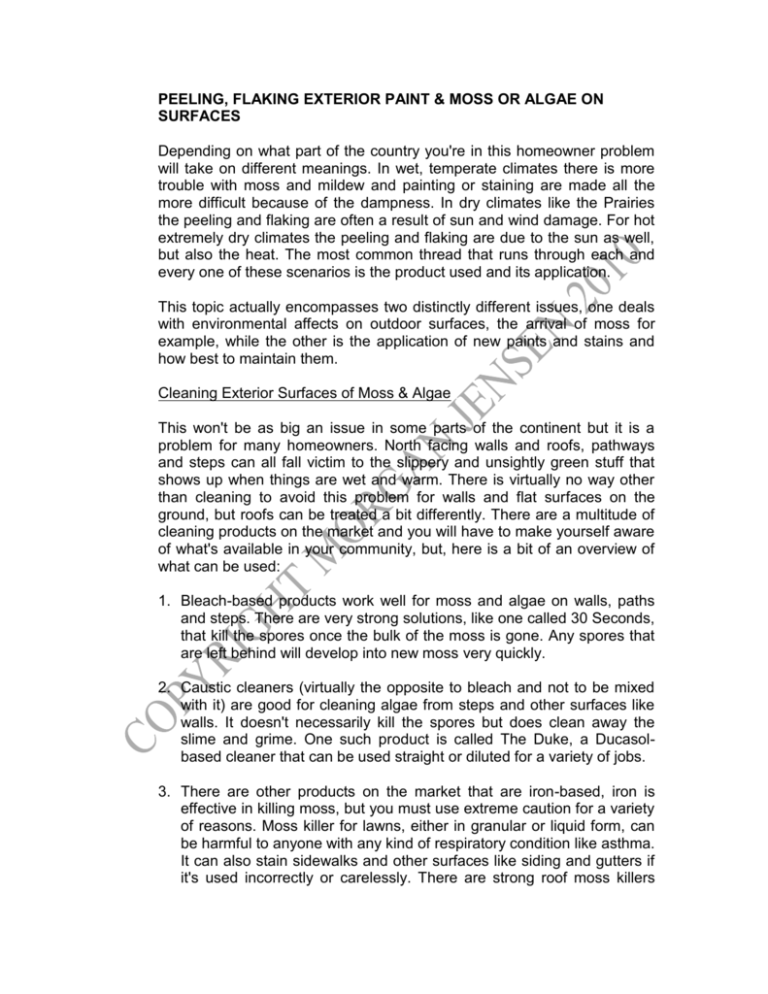
PEELING, FLAKING EXTERIOR PAINT & MOSS OR ALGAE ON SURFACES Depending on what part of the country you're in this homeowner problem will take on different meanings. In wet, temperate climates there is more trouble with moss and mildew and painting or staining are made all the more difficult because of the dampness. In dry climates like the Prairies the peeling and flaking are often a result of sun and wind damage. For hot extremely dry climates the peeling and flaking are due to the sun as well, but also the heat. The most common thread that runs through each and every one of these scenarios is the product used and its application. This topic actually encompasses two distinctly different issues, one deals with environmental affects on outdoor surfaces, the arrival of moss for example, while the other is the application of new paints and stains and how best to maintain them. Cleaning Exterior Surfaces of Moss & Algae This won't be as big an issue in some parts of the continent but it is a problem for many homeowners. North facing walls and roofs, pathways and steps can all fall victim to the slippery and unsightly green stuff that shows up when things are wet and warm. There is virtually no way other than cleaning to avoid this problem for walls and flat surfaces on the ground, but roofs can be treated a bit differently. There are a multitude of cleaning products on the market and you will have to make yourself aware of what's available in your community, but, here is a bit of an overview of what can be used: 1. Bleach-based products work well for moss and algae on walls, paths and steps. There are very strong solutions, like one called 30 Seconds, that kill the spores once the bulk of the moss is gone. Any spores that are left behind will develop into new moss very quickly. 2. Caustic cleaners (virtually the opposite to bleach and not to be mixed with it) are good for cleaning algae from steps and other surfaces like walls. It doesn't necessarily kill the spores but does clean away the slime and grime. One such product is called The Duke, a Ducasolbased cleaner that can be used straight or diluted for a variety of jobs. 3. There are other products on the market that are iron-based, iron is effective in killing moss, but you must use extreme caution for a variety of reasons. Moss killer for lawns, either in granular or liquid form, can be harmful to anyone with any kind of respiratory condition like asthma. It can also stain sidewalks and other surfaces like siding and gutters if it's used incorrectly or carelessly. There are strong roof moss killers that are iron-based but these should not be used for the reasons mentioned. 4. Elbow grease always works too, although it isn't as effective in keeping the moss at bay for very long. Prevention is always a good thing to teach your customers. If there are places around their property where moss and algae are constant problems and even dangerous, there are things that a homeowner can do: 1. Open up the space to more airflow. Airflow, sunlight and dryness are all enemies of moss and algae. They like it dark and damp with nice still air. Tree and shrub trimming can be done, as well as examining the way fences and other obstructions work near the house. Perhaps removing a solid fence and either leaving it open or adding an open, chain link fence would work. Re-locating a shed that may restrict airflow is a good idea too. Cutting back trees and shrubs is critical to the health of a house and should be a part of an annual maintenance schedule. 2. Change path surfaces from solid and potentially slippery to coarse and porous. 3. Install some sort of anti-slip strips on stairs even asphalt shingles if need be, to reduce the falling hazard. This is very important for seniors or anyone who is a bit unsteady on their feet. There are stainless steel grids available on the market too (getagripstairtreads.com). 4. For roofs, sloped or flat, the homeowner should use zinc-based products that come either as rolls of striping or tubs of granules. The zinc leaches across the roof as it rains and creates an environment that is unfriendly to the moss and algae. This should be replaced every couple of years regardless of what it says on the product. 5. Keep things clean and dry as much as possible. This means removing leaves and other debris as they occur and keeping things tidy and unobstructed. Peeling & Flaking Paint Once any moss or algae has been removed from exterior walls the homeowner may then have to tackle loose paint or stain. There are a variety of reasons why this happens but the most common one is poor preparation before application. Paint and stain can become 0old and fail over time, but this usually results in fading and thinning, not actual peeling of pieces of product. Here are some common mistakes made when getting ready to coat an outside surface: 1. Coating damp or even wet material. The surface may seem dry enough but if the weather has been wet, or if the wood is newly installed, the moisture content may still be too high. This is particularly critical for any oil-based product. Oil paints and stains, unlike latex or acrylic products, cannot "breathe" and form a solid membrane that traps moisture. Once the sun comes around and hits the wood surface the trapped water tries to escape thus causing bubbles. 2. Coating over existing paints or stains and not knowing what they are. There is a standards rule about placing latex products over oil but they needn't always mean failure. Preparation is crucial in this case too. When the homeowner doesn't know what was there they can still scrape, wash with a TSP solution (trisodium phosphate), and sand. Once the surface is clean and dry the homeowner would apply a top quality exterior wood primer to establish a good base before final painting. 3. A common error made often is painting or staining when it's too hot, or when the sun is directly on the surface. When any coating dries too quickly the surface hardens and the under layer stays soft. The product doesn't have a chance to cure properly and eventually fails. Care must be taken when applying any exterior coating in the summer. 4. Using the right tools is also important such as the right type of brush and roller. It doesn't pay to use cheap tools the result will tell the story. 5. Finally the homeowner should always use the right product for the job at hand. There can be a lot of difference between coatings and many, even expensive ones, will not be applicable for every surface or use. The homeowner should take care to give the right information at the store in order to get the right product. Peeling and flaking of old paint and stain can be dealt with as long as a step-by-step approach is used. Council your customers to take their time, do their homework first, and call in the experts when there's any doubt. Copyright Morgan Jensen 2010



